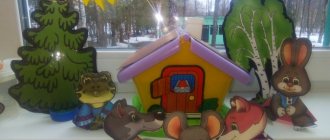Work plan on healthy lifestyle in the junior group
Long-term plan for healthy lifestyle
in the younger group.
Month
Theme
Joint activities of children and teacher
Interaction with parents and social partners
Contents and forms of work with children
September
VITAMINS FROM THE GARDEN
1. NOD OO “Cognitive Development” Game-activity “Where do vegetables grow?”
Program content: to form children's ideas about healthy foods, talk about the benefits of vegetables for human health, and the benefits of vitamins. Encourage children to want to eat as many vegetables as possible.
Questioning parents on the topic “How to take care of health in your family.”
Purpose: obtaining and analyzing information about parents’ attitudes towards issues of a healthy lifestyle for children.
Planning work based on the information received on this topic for the new academic year. Traditional competition of joint family works “Autumn Vernissage”.
2. Didactic game “Guess the taste.”
Program content: clarify the names of fruits and vegetables, develop the ability to identify them by taste, name and describe them.
3. Role-playing game “Supermarket vegetable department.”
Program content: continue to acquaint children with the profession of a seller, a supermarket cashier and the actions they perform when making a sale. Develop the ability to interact and get along with each other in a joint game. Fixing the names of vegetables and fruits, fostering a culture of behavior in public places.
4. NGO “Artistic and aesthetic development.
Modeling according to the “Potatoes in a bag” model.
Program content: teach children to roll small balls of plasticine between their palms and flatten them on top with their finger on cardboard.
To consolidate children's knowledge and ideas about vegetables and their benefits. Month
Theme
Joint activities of children and teacher
Interaction with parents and social partners
Contents and forms of work with children
October
MY HEALTH
1. Conversation “Be healthy!”
Program content: to form children’s primary ideas about health and their body. Cultivate a desire to take care and protect your health.
2. Didactic game “What is good and what is bad.”
Program content: introduce children to the rules of personal hygiene and proper, careful attitude towards their health; develop children's speech, attention, and memory.
3. Role-playing game “The bear is sick.”
Program content: continue to introduce children to the medical profession and the manipulations performed by medical workers. Learn to join together to play in small groups (2-3 people). Develop the ability to interact and get along with each other in a joint game.
4. Reading thin. literature: K.I. Chukovsky “Aibolit”.
Program content: formation of primary ideas about the medical profession.
Consultation: “Children’s clothing in autumn”
Month
Topic
Joint activities of children and teacher
Interaction with parents and social partners
Contents and forms of work with children
november
MY HYGIENE
1. Conversation “The grimy girl.”
Program content: developing healthy lifestyle skills, consolidating washing skills, forming ideas about the purpose of toilet items, cultivating cultural and hygienic skills, the desire to always be clean, beautiful, and neat.
Excursion to the doctor’s office “Doctors are our assistants.”
Goal: to expand children’s understanding of the work of a doctor and a nurse.
2. Didactic game “Why do we need a handkerchief.”
Program content: Formation of skills in using a handkerchief. Teach children to turn away when coughing and sneezing and cover their mouth with a handkerchief.
3. Role-playing game “Beautiful haircut”.
Goal: to continue to form ideas about the work of a hairdresser, to cultivate a culture of behavior in public places. Develop the ability to interact and get along with each other in a joint game, distribute roles.
4. Reading thin. Literature: A. Barto “The Dirty Girl.”
Program content: to cultivate cultural and hygienic skills, the desire to always be clean, beautiful, and neat.
Month
Theme
Joint activities of children and teacher
Interaction with parents and social partners
Contents and forms of work with children
December
CLOTHING AND MY HEALTH
1. Conversation “Why did the guys get sick?”
Program content: familiarize children with the signs of diseases, rules of conduct in case of illness; develop skills and abilities to meet hygienic requirements for clothing; develop speech and thinking.
Round table with parents “Healthy lifestyle in the family.”
Goal: exchange of parents’ experiences in preserving and strengthening the health of preschool children in the family.
2. Didactic game “I’m going for a walk.”
Program content: Learn to dress in accordance with the seasons and weather; cultivate neatness, the desire to take care of one’s appearance.
3. Role-playing game “Let’s dress Varya the doll for a walk.”
Program content: consolidate knowledge of clothing items; develop children’s ability to dress a doll according to the season of the year, the weather, systematize children’s ideas about health, and develop self-care skills; develop the ability to interact with each other in a joint game.
4. Reading poems by M. Fisenko “Confused”, “Spots on your shirt”.
Program content: consolidate children's knowledge about the types and purposes of clothing.
Month
Theme
Joint activities of children and teacher
Interaction with parents and social partners
Contents and forms of work with children
January
MY BODY
1. Conversation “This is who I am.”
Program content: introduce children to the structure of the human body and the capabilities of its body:
- I can run, jump, sing, watch, listen, eat, endure heat and cold, endure pain, breathe, think, help other people;
- cultivate a sense of pride that “I am a man”;
- arouse interest in further knowledge of oneself.
Release of a leaflet for parents “Healthy lifestyle”.
2. Didactic game “Health Town”.
Program content: Clarify and expand children's knowledge about the basic values of a healthy lifestyle; promote conscious participation in them.
3. Role-playing game “At the trauma center.”
Program content: consolidate children's knowledge about the structure of the body, develop the ability to interact with each other in joint play.
4. Review of the encyclopedia “Me and My Body.”
Program content: expand children's ideas about their body (organism).
Month
Theme
Joint activities of children and teacher
Interaction with parents and social partners
Contents and forms of work with children
February
VITAMINS FOR HEALTH
1. Conversation “Meet the vitamins.”
Program content: to form ideas about the importance of vitamins for human health. Introduce the proverb. Introduce the following words into children's active vocabulary: vitamins, health. Cultivate a desire to lead a healthy lifestyle.
Issue of the newspaper “Be Healthy”.
Goal: to introduce parents to health-saving technologies used in preschool institutions.
2. Didactic game “Healthy and harmful foods.”
Program content: systematize children's ideas about harmful and healthy products, exercise their ability to differentiate them, and develop the need to take care of their health.
3. Role-playing game “Tanya caught a cold.”
Program content: consolidate knowledge about handkerchiefs and rules of use; the benefits of vitamins; the ability to interact with each other in a joint game.
4. NGO “Artistic and aesthetic development.
Modeling based on the “Vitamins for Animals” model.
Program content: to form children’s primary ideas about the importance of vitamins.
Teach children to roll out plasticine in a circular motion. Month
Theme
Joint activities of children and teacher
Interaction with parents and social partners
Contents and forms of work with children
March
IN A HEALTHY BODY HEALTHY MIND!
1. Conversation “I take care of my health.”
Program content: Teach children to independently monitor their health, teach simple self-massage techniques. Develop children's spoken language. Instill and cultivate a love of physical exercise.
Designing, together with parents, a thematic photo exhibition on the theme: “Little athletes.”
Consultation for parents “Physical education of a child in the family.”
2. Didactic game “If you want to be healthy.”
Program content: to develop children's needs to be healthy. Develop cultural and hygienic skills.
3. Entertainment “Olympic Reserves”.
Program content: to form ideas about the influence of physical exercise on the human body; cultivate a love of physical exercise; to form elements of self-control during various motor activities.
4. Watching a cartoon based on the poem “Moidodyr” by K. Chukovsky.
Program content: continue to form children's ideas about the importance and necessity of hygiene procedures and hardening.
Develop cultural and hygienic skills. Month
Theme
Joint activities of children and teacher
Interaction with parents and social partners
Contents and forms of work with children
April
DENTAL HEALTH
1. Conversation “So that your teeth don’t hurt.”
Program content: to form children’s primary ideas about the structure of teeth; teach simple dental care techniques; develop a desire to take care of your teeth.
Design of information cards for parents “Lessons from Clean”.
Purpose: to familiarize parents with the algorithm for brushing the teeth of preschool children.
2. Didactic game “Rules of Cleanliness”.
Program content: consolidation of acquired knowledge about dental health; learn to distinguish between healthy and diseased teeth on cards.
3. Role-playing game “At the dentist’s office.”
Program content: to form ideas about the work of a dentist, the manipulations performed by a doctor when examining a patient; consolidate knowledge of personal hygiene items (toothbrush, tube, tooth powder) and their purpose and proper use; develop the ability to interact with each other in a joint game.
4. Watching the cartoon “Bird Tari” (Soyuzmultfilm, 1976).
Program content: to form children's understanding of the need for preventive dental care.
Month
Theme
Joint activities of children and teacher
Interaction with parents and social partners
Contents and forms of work with children
May
MY SAFETY
1. Conversation “Walking carefully.”
Program content: Teach children the rules of moving on the streets; talk about the dangers that may await us on the street.
Targeted walk to the traffic light together with parents “Safe Street”.
Goal: to consolidate children’s knowledge of the rules of safe behavior on city streets.
2. Didactic game “Dangerous objects”.
Program content: Introduce children to objects that may be hazardous to human health
3. Game-situation “On the playground”.
Program content: To form children's ideas about sources of potential danger on the playground, about the rules of safe behavior when walking.
4. NGO “Artistic and aesthetic development.
Drawing according to the theme: “Safe Street”
Program content: to develop knowledge about the rules of behavior on the street, in kindergarten, at home.


